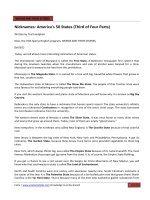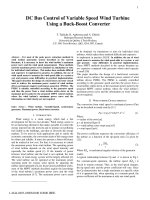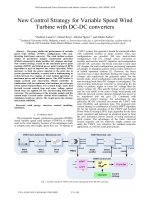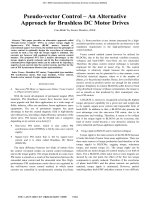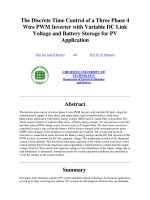Direct torque control of four switch brushless DC motor with non sinusoidal back EMF
Bạn đang xem bản rút gọn của tài liệu. Xem và tải ngay bản đầy đủ của tài liệu tại đây (695.44 KB, 7 trang )
4730
Direct Torque Control of Four-Switch Brushless
DC Motor with Non-sinusoidal Back-EMF
Salih Baris Ozturk
*
William C. Alexander
**
Hamid A. Toliyat
*
Student Member, IEEE Member, IEEE Fellow, IEEE
Advanced Electric Machines & Power Electronics Laboratory
*
Department of Electrical & Computer Engineering Ideal Power Converters, Inc.
**
Texas A&M University Austin, TX
College Station, TX 77843-3128 Phone: (512) 560-0774
Phone: (979) 862-3034 Phone: 82-(43)-2298440
E-mail: Email:
Abstract—This paper presents a direct torque control (DTC)
technique for brushless dc (BLDC) motors with non-
sinusoidal back-EMF using four-switch inverter in the
constant torque region. This approach introduces a two-
phase conduction mode as opposed to the conventional
three-phase DTC drives. Unlike conventional six-step PWM
current and voltage control schemes, by properly selecting
the inverter voltage space vectors of the two-phase
conduction mode from a simple look-up table at a
predefined sampling time, the desired quasi-square wave
current is obtained. Therefore, a much faster torque
response is achieved compared to conventional PWM
current and especially voltage control schemes. In addition,
for effective torque control in two phase conduction mode, a
novel switching pattern incorporating with the voltage
vector look-up table is designed and implemented for four-
switch inverter to produce the desired torque
characteristics. Furthermore, to eliminate the low-frequency
torque oscillations caused by the non-ideal trapezoidal
shape of the actual back-EMF waveform of the BLDC
motor, pre-stored back-EMF constant versus position look-
up tables are designed and used in the torque estimation. As
a result, it is possible to achieve two-phase conduction DTC
of a BLDC motor drive using four-switch inverter with
faster torque response due to the fact that the voltage space
vectors are directly controlled. Therefore, the direct torque
controlled four-switch three-phase BLDC motor drive could
be a good alternative to the conventional six-switch
counterpart with respect to low cost and high performance.
A theoretical concept is developed and the validity and
effectiveness of the proposed two phase conduction four-
switch DTC scheme are verified through the simulations
and experimental results.
I. I
NTRODUCTION
Brushless dc motors have been used in variable speed
drives for many years due to their high efficiency, high
power factor, high torque, simple control, and lower
maintenance [1]. Low cost and high efficiency variable
speed motor drives have had growing interest over the
years. Minimizing the switch counts has been proposed in
[2, 3, 4, and 5] to replace the traditional six-switch three-
phase inverter.
In this paper, unlike the methods discussed in [2, 4, 5],
a novel direct torque control scheme including the actual
pre-stored back-EMF constants vs. electrical rotor position
look-up table is proposed for BLDC motor drive with two-
phase conduction scheme using four-switch inverter.
Therefore, low-frequency torque ripples and torque
response time are minimized compared to conventional
four-switch PWM current and voltage controlled BLDC
motor drives. This is achieved by properly selecting the
inverter voltage space vectors of the two-phase conduction
mode from a simple look-up table at a predefined
sampling time.
The four-switch DTC of a BLDC motor drive operating
in two-phase conduction mode which is similar to [6] is
simplified to just a torque controlled drive by intentionally
keeping the stator flux linkage amplitude almost constant
by eliminating the flux control in the constant torque
region. It is shown that in the constant torque region under
the two-phase conduction DTC scheme using four-switch
(or six-switch) inverter, the amplitude of the stator flux
linkage cannot easily be controlled due to the sharp
changes and the curved shape of the flux vector between
two consecutive commutation points in the stator flux
linkage locus. Since the flux control along with PWM
generation is removed, fewer algorithms are required for
the proposed control scheme.
Specifically, it is shown that rather than attempting to
control the stator flux amplitude in two-phase conduction
DTC of BLDC motor drive, only the electromagnetic
torque is controlled. In the proposed method, a simple
two-phase four-switch inverter voltage space vector look-
up table is developed to control the electromagnetic
torque. Moreover, to obtain smooth torque characteristics
a new switching logic is designed and incorporated with
the two-phase four-switch voltage space vector look-up
table. Simulated and experimental results are presented to
illustrate the validity and effectiveness of the two-phase
four-switch DTC of a BLDC motor drive in the constant
torque region.
II. T
HE
P
ROPOSED FOUR
-
SWITCH
D
IRECT
T
ORQUE
C
ONTROL OF
BLDC M
OTOR
D
RIVE
A. Principles of the Proposed Four-Switch Inverter
Scheme
The key issue in the proposed four-switch DTC of a
BLDC motor drive in the constant torque region is to
estimate the electromagnetic torque correctly similar to
the six-switch version given in [6]. For a surface-mounted
BLDC motor the back-EMF waveform is non-sinusoidal
978-1-4244-1668-4/08/$25.00 ©2008 IEEE
4731
T
ea
e
a
i
a
ș
e
Phase A
Phase B
Phase C
ș
e
ș
e
T
eb
T
ec
e
b
e
c
i
b
i
c
30° 90° 150° 210° 270° 330°
I II III IV V VI I
Figure 1. Actual (realistic) phase back-EMF, current, and phase
torque profiles of the three-phase BLDC motor drive with four-
switch inverter.
a
H
Hall-1
b
H
Hall-2
c
H
Hall-3
2H
K
Figure 2. Actual (solid curved line) and ideal (straight dotted line)
stator flux linkage trajectories, representation of the four-switch
two-phase voltage space vectors, and placement of the three hall-
effect sensors in the stationary Įȕ–axes reference frame (V
dc_link
=
V
dc
).
(trapezoidal), irrelevant of conducting mode (two or three-
phase), therefore (1) which is given in the stationary
reference frame should be used for the electromagnetic
torque calculation [6, 7, 8].
33
() () .
22 22
em s e s e
ss
ee
e
e
PP
Tiikiki
C
B
BBB
CCC
RR
XX
¯
¯
¡°
¡°
¡°
¢±
¡°
¢±
(1)
where P is the number of poles, ș
e
is the electrical rotor
angle, Ȧ
e
is the electrical rotor speed, and k
Į
(ș
e
), k
ȕ
(ș
e
),
e
Į
, e
ȕ
, i
sĮ
, i
sȕ
are the stationary reference frame (Įȕ–axes)
back-EMF constants, motor back-EMFs, and stator
currents, respectively. Since the second equation in (1)
does not involve the rotor speed in the denominator there
will be no problem estimating the torque at zero and near
zero speeds. Therefore, it is used in the proposed control
system instead of the one on the left in (1).
The Įȕ–axes rotor flux linkages ij
rĮ
and ij
rȕ
are obtained
as
rsss
rsss
L i
L i
BB B
CC C
KK
KK
(2)
where ij
sĮ
and ij
sȕ
are the Į– and ȕ–axis stator flux
linkages, respectively. By using (2), reference stator flux
linkage command |ij
s
(ș
e
)|
*
for DTC of BLDC motor drive
in the constant torque region can be obtained similar to the
DTC of a PMSM drive as
*
22
() () () ().
se re r e r eBC
KR KR K R K R
(3)
Since the electromagnetic torque is proportional to the
product of back-EMF and its corresponding current, the
phase currents are automatically shaped to obtain the
desired electromagnetic torque characteristics using (1).
When the actual stationary reference frame back-EMF
constant waveforms from the pre-stored look-up table are
used in (1), much smoother electromagnetic torque is
obtained as shown in Fig. 1.
As can be observed in Fig. 1 that to generate constant
electromagnetic torque due to the characteristics of the
BLDC motor, such as two-phase conduction, only two of
the three phase torque are involved in the total torque
equation during every 60 electrical degrees and the
remaining phase torque equals zero as shown in Table I.
The total electromagnetic torque of PMAC motors equals
the summation of each phase torque which is given by
em ea eb ec
T TTT
(4)
It has been observed from the stator flux linkage
trajectory that when conventional two-phase four-switch
PWM current control is used sharp dips occur every 60
electrical degrees. This is due to the operation of the
freewheeling diodes. The same phenomenon has been
noticed when the DTC scheme for a BLDC motor is used,
as shown in Fig. 2. Due to the sharp dips in the stator flux
linkage space vector at every commutation (60 electrical
degrees) and the tendency of the currents to match with
the flat top portion of the phase back-EMF for smooth
TABLE I
E
LECTROMAGNETIC
T
ORQUE
E
QUATIONS FOR THE
O
PERATING
R
EGIONS
Mode I (0°<ș<30°) T
em
= T
eb
+ T
ec
and T
ea
= 0
Mode II (30°<ș<90°) T
em
= T
ea
+ T
eb
and T
ec
= 0
Mode III (90°<ș<150°) T
em
= T
ea
+ T
ec
and T
eb
= 0
Mode IV (150°<ș<210°) T
em
= T
eb
+ T
ec
and T
ea
= 0
Mode V (210°<ș<270°) T
em
= T
ea
+ T
eb
and T
ec
= 0
Mode VI (270°<ș<330°) T
em
= T
ea
+ T
ec
and T
eb
= 0
4732
TABLE II
T
WO
-
PHASE FOUR
-
SWITCH VOLTAGE VECTOR SELECTION FOR DTC OF BLDC MOTOR DRIVE
(CCW)
Note: The italic grey area and vectors in the “X” area are not used in the proposed four-switch DTC of a BLDC motor drive.
TABLE III
V
OLTAGE VECTOR SELECTION IN SECTORS II AND V FOR FOUR
-
SWITCH DTC OF BLDC MOTOR DRIVE
(CCW)
(a)
(b)
(c)
(d)
(e)
(f)
(g)
(h)
Figure 3. Proposed four-switch voltage vector topology for two-
phase conduction DTC of BLDC motor drives. (a) V
1
(1000) vector,
(b) V
2
(0010) vector, (c) V
3
(0110) vector, (d) V
4
(0100) vector, (e)
V
5
(0001) vector, (f) V
6
(1001), (g) V
7
(0101), and (h) V
0
(1010).
torque generation, there is no easy way to control the
stator flux linkage amplitude. On the other hand, rotational
speed of the stator flux linkage can be easily controlled,
therefore fast torque response is obtained. The size of the
sharp dips is quite unpredictable and depends on several
factors such as sampling time, dc-link voltage, hysteresis
bandwidth, motor parameters especially the winding
inductance, motor speed, snubber circuit, and the amount
of load torque The best way to control the stator flux
linkage amplitude is to know the exact shape of it, but it is
considered too cumbersome in the constant torque region.
If the effect of unexcited open phase back-EMF and the
free-wheeling diodes are neglected more hexagonal shape
of stator flux locus can be obtained as shown in Fig. 2
with straight dotted lines. However, the stator flux locus
obtained in the actual implementation is shown in Fig. 2
with solid curved lines. Therefore, in the four-switch DTC
of a BLDC motor drive with two-phase conduction
scheme, the flux error ij in the voltage vector selection
look-up table is always selected as zero and only the
torque error IJ is used depending on the error level of the
actual torque from the reference torque.
B. Control of Electromagnetic Torque by Selecting the
Proper Stator Voltage Space Vectors
To obtain the six modes of operation in four-switch
DTC of BLDC motor drive, a simple voltage vector
selection look-up table is designed as shown in Table II.
Normally, six-possible voltage space vectors of four-
switch topology are supposed to be used in Table II as
shown in Fig. 3(a)–(f) similar to the six-switch version,
however two of the voltage vectors V
3
and V
6
as shown in
Fig. 3 create problems in the torque control. When they
are directly used in the voltage vector selection table
(Table II), back-EMF of the uncontrolled phase (phase–c)
generates undesired current therefore distortions occur in
each phase torque. As a result, undesired electromagnetic
torque is inevitable. Therefore, when the rotor position is
in the Sector II and V, special switching pattern should be
adapted, as shown in Table III (CCW). At Sectors II and
V, phase–a and –b torque are independently controlled by
the hysteresis torque controllers. Additional two voltage
vectors V
0
and V
7
which are used in conventional four-
switch PWM scheme are included in the voltage selection
4733
R
s
L
s
R
s
L
s
C
C
e
an
e
bn
n
c
T
ec
§ 0
Inv.
Inv.
+
-
+
-
T
ea
= T
ref
/2
1
-1
1
-1
T
ea
= e
a
i
a
/Ȧ
m
T
eb
= T
ref
/2
T
eb
= e
b
i
b
/Ȧ
m
S1
S2
S3
S4
T
ea
and T
eb
hysteresis control
Figure 4. Individual phase–a and –b torque control, T
ea
and T
eb
,
in Sectors 2 and 5.
look-up table to obtain smooth torque production in two-
phase conduction four-switch DTC of BLDC motor drive.
Since the upper and lower switches in a phase leg may
both be simultaneously off, irrespective of the state of the
associated freewheeling diodes in two-phase conduction
mode, four digits are required for the four-switch inverter
operation, one digit for each switch [8]. Therefore, there is
a total of eight useful voltage vectors for the two-phase
conduction mode in the proposed DTC of BLDC motor
drive which can be represented as V
0,1,2,…,6,7
(SW
1
, SW
2
,
SW
3
, SW
4
), as shown in Fig. 2. The eight possible two-
phase four-switch voltage vectors and current flow are
depicted in Fig. 3.
The detailed switching sequence and torque regulation
are showed in Fig. 4 for four-switch DTC of BLDC motor
drive. The overall block diagram of the closed-loop four-
switch DTC scheme of a BLDC motor drive in the
constant torque region is represented in Fig. 5. The dotted
area represents the stator flux linkage control part of the
scheme used only for comparison purpose. When the two
switches in Fig. 5 are changed from state 2 to state 1, flux
control is considered in the overall system along with
torque control. In the two-phase conduction mode the
shape of stator flux linkage trajectory is ideally expected
to be hexagonal, as illustrated with the straight dotted lines
in Fig. 2. However, the influence of the unexcited open-
phase back-EMF causes each straight side of the ideal
hexagonal shape of the stator flux linkage locus to be
curved and the actual stator flux linkage trajectory tends to
be more circular in shape, as shown in Fig. 2 with solid
curved lines [8].
The actual values of Įȕ–axes back-EMF constants k
Į
and k
ȕ
vs. electrical rotor position ș
e
can be created in the
look-up table, respectively with great precision depending
on the resolution of the position sensor (for example
incremental encoder with 2048 pulses/revolution),
therefore a good torque estimation can be obtained in (1).
C. Torque Control Strategies of the Uncontrolled
Phase-c
For direct torque control, Fig. 3(g) and (h) are not
applicable due to the three-phase conduction mode
instead of a desired two-phase conduction. Modification
in PWM scheme presented in [4, 5] could be a solution if
not for its tedious computation. If torque or current is
going to be controlled using hysteresis controllers, then
those voltage space vectors cannot be used in two-phase
BLDC motor drive. On the other hand, even though
voltage vectors shown in Fig. 3(c) and (f) are two-phase
conductions through phase–a and –b, there will be always
current trying to flow in phase–c due to its back-EMF and
the absence of switches controlling its current. As a
result, there will be a distorted current in phase–c as well
as in phase–a and –b. Therefore, voltage space vectors of
phase–a and –b conduction can be difficult to implement
for BLDC motor drive unless some modifications are
applied to overcome the back-EMF effect of the phase–c
in these conditions. Selecting the right switching pattern
to control the torque on phase–a and –b independently
will reduce the distorted currents on those phases and
result in a smoother overall electromagnetic torque
production, which is shown in the simulations. Solution
to the above phenomenon is explained in detail below:
For BLDC motor with two-phase conduction, one of
the phase torque should be zero as shown in Table I. This
can be achieved in Sectors 1, 3, 4 and 6 whereas in
Sectors 2 and 5 phase–c torque T
ec
is uncontrollable due
to the split capacitors. In Sectors 2 and 5, voltage vectors
V
3
and V
6
cannot be directly used, instead phase torque
T
ea
and T
eb
should be individually controlled by properly
selecting the S1, S2, S3, and S4 switches, such as if the
rotor position resides in Sector 2 and the rotor rotates in
CCW direction then to increase the phase–a torque T
ea
S1
should be “0” and S2 is “1” and vice versa to decrease the
T
ea
. To increase the phase–b torque T
eb
S3 should be “0”
and S4 should be “1” and vice versa to decrease the T
eb
.
Reference torque value for those phase torque should be
half of the desired total reference torque T
earef
= T
ebref
=
T
ref
/2. This special torque control phenomenon can be
explained with the aid of the simplified equivalent circuit
in Fig. 4. Consequently, in Mode II and V only phase–a
and –b torque are controlled independently and therefore
the T
ec
is tried to be kept at zero value. This will eliminate
the distorted torque problem on each phase in two-phase
conduction four-switch DTC of a BLDC motor drive.
The direction of the rotor is important to define the
specific switching pattern. If the rotor direction is CW,
then the above claims are reversed, such as in Sector 2 to
increase the phase–a torque T
ea
S1 is “1” and S2 is “0”
and vice versa for decrementing the T
ea
. The same is true
for the phase–b torque T
eb
.
Another problem to overcome is eliminating the high
torque ripples in Mode 2 and 5 where full dc-link is
applied to the motor terminals compared to the other
sectors where only half and one third of the dc-link
voltage is used. During Sectors 2 and 5 where the
individual torque control is performed, bandwidth of the
hysteresis torque controllers are chosen about 1000 times
less than the normal case which is used in Sectors 1, 3, 4,
and 6. Therefore, ripples in the current and eventually in
the torque are equalized during the entire electrical cycle.
From the equivalent circuit given in Fig. 4, if phase–a
and –b torque are individually controlled as explained
4734
3
() ()
22
em es es
P
Tkiki
DDEE
TT
dtiRV
dtiRV
ssss
sasss
³
³
EEE
DD
M
M
22
ED
MMM
sss
¸
¸
¹
·
¨
¨
©
§
D
E
M
M
s
s
1
tan
s
T
*
()
se
M T
e
T
m
T
2
P
em
T
30
D
Figure 7. Overall block diagram of the four-switch two-phase conduction DTC of a BLDC motor drive in the constant torque region.
Figure 5. Simulated open-loop stator flux linkage trajectory under
the four-switch two-phase conduction DTC of a BLDC motor drive
at 1.2835 N·m load torque (speed + torque control).
-0.1 -0.05 0 0.05 0.1 0.15
-0.1
-0.05
0
0.05
0.1
0.15
Alfa-axis stator flux linkage (Wb)
Beta-axis stator flux linkages (Wb)
Figure 8. Simulated stator flux linkage locus whose reference is
chosen from (3) under full load (speed + torque + flux control).
-0.2 -0.1 0 0.1 0.2
-0.4
-0.3
-0.2
-0.1
0
0.1
0.2
0.3
Alfa-axis stator flux linkage (Wb)
Beta-axis stator flux linkage (Wb)
Figure 6. Simulated electromagnetic torque when just torque is
controlled without flux control under 0.5 N·m load using actual
back-EMFs (reference torque is 0.51 N·m).
0 0.2 0.4 0.6 0.8 1
-0.5
0
0.5
1
1.5
Time (s)
Electromagnetic torque (N.m)
above, the influence of the back-EMF of the phase–c can
be blocked, there is no current flow in phase–c, therefore
its torque (T
ec
) will be almost zero. As a result, in Sectors
2 and 5, phase–a and –b torque should be controlled
independently, in other words switching signals at S1 (or
S2) and S4 (or S3) should be created individually making
additional voltage vectors V
0
and V
7
which act as a zero
voltage vector at Sectors 2 and 5 in four-switch DTC of a
BLDC motor drive scheme using two phase conduction
mode. Additional voltage vectors and their logic
depending on the errors of phase–a and –b torque are
depicted in Table III.
At Sectors 2 and 5, complementary switches in both
phase–a and –b legs cannot be turned off at the same time
as in V
4
and V
5
, therefore inverse logic is applied in Fig.
4.
III. S
IMULATION
R
ESULTS
The drive system shown in Fig. 5 has been simulated
for various cases with and without stator flux control,
switch states 1 and 2, respectively in order to demonstrate
the validity of the proposed four-switch DTC of a BLDC
motor drive scheme with two-phase conduction.
Phase-c torque T
emc
effect
4735
(a)
(b)
Figure 10. Experimental test-bed. (a) Four-switch inverter and DSP
control unit. (b) BLDC motor coupled to dynamometer and
position encoder (2048 pulse/rev).
abc frame currents [2 A/div]
Time [16.07 ms/div]
Electromagnetic torque [0.5 N.m/div]
Figure 9. Top: Steady-state and transient experimental
electromagnetic torque in per-unit under 0.5 N·m load torque (0.5
N·m/div). Bottom: Steady-state and transient experimental abc
frame phase currents (2 A/div) and Time base: 16.07 ms/div.
The magnitudes of the torque hysteresis band used in
Sectors 1, 3, 4, and 6 IJ
1,3,4,6
, and flux hysteresis band are
0.08 N·m and 0.001 Wb, respectively. Torque hysteresis
bandwidth in Sectors 2 and 5 IJ
2,5
is chosen as 0.08/1000
N·m to equal the high frequency ripple width of both
current and torque in one complete electrical cycle.
Fig. 6 shows the simulation results of the uncontrolled
open-loop stator flux linkage locus when 1.2835 N·m load
torque is applied to the BLDC motor with actual back-
EMF waveforms, respectively. Steady-state speed control
is performed with an inner-loop torque control without
flux control. As can be seen in Fig. 6 when the load torque
level increases, more deep sharp changes are observed
which increase the difficulty of the flux control if it is
used in the control scheme.
Using the actual Įȕ–axes rotor flux linkages in (3)
looks like the best solution for a good stator flux reference
similar to the DTC of a PMSM drive. Unlike BLDC
motor, in PMSM since both Į–andȕ–axis motor back-
EMFs are in sinusoidal shape, constant stator flux linkage
amplitude is obtained. However, for BLDC motor,
unexcited open-phase back-EMF effect on the flux locus
and more importantly the size of the sharp dips cannot
easily be predicted to achieve a good stator flux reference
in two-phase conduction mode. Fig. 7 represents the
steady-state estimated stator flux locus whose reference
obtained in (3) when back-EMF is not ideally a
trapezoidal under full-load (1.2835 N·m). The simulation
time for this case is 3 seconds. The motor speed is 30
mechanical rad/s. Due to the distorted voltage and current,
the estimation of stator flux locus goes unstable as can be
seen in Fig. 8.
There should be exact flux amplitude to be given as a
reference flux value including sharp changes at every
commutation point and curved shape between those
commutation points, then appropriate flux control can be
obtained without losing the torque control. However, to
predict all these circumstances to generate a flux reference
is a cumbersome work which is unnecessary in the
constant torque region.
Fig. 8 shows electromagnetic torque under only torque
control when the actual phase back-EMFs are considered
in the simulation. The torque ripples of phase–c as a
consequence of individual torque control scheme are not
large enough to distort the torque estimation as illustrated
with grey circle in Fig. 8. The size of the torque hysteresis
bandwidth at Sectors 2 and 5 IJ
2,5
is still kept as IJ
1,3,4,6
/1000 N·m. In Fig. 8, reference torque is 0.51 N·m and the
load torque is 0.5 N·m, thereby steady-state speed is kept
around 30 electrical rad/s for a better circular flux locus.
IV. E
XPERIMENTAL
R
ESULTS
The feasibility and practical features of the proposed
four-switch DTC of a BLDC motor drive scheme have
been evaluated using an experimental test-bed, shown in
Fig. 9. In this section, transient and steady-state torque and
current responses of the proposed four-switch two-phase
conduction DTC scheme of a BLDC motor drive are
demonstrated experimentally under 0.5 N·m load torque
condition.
Fig. 10 illustrates the experimental results of the torque
and abc frame phase currents when only torque control is
performed using (1). In Fig. 10, the reference torque is
suddenly increased 25 percent from 0.51 N·m to 0.6375
N·m at 0.05 s under 0.5 N·m load torque. The sampling
time is chosen as 25 ȝs, hysteresis bandwidth is 0.05 N·m
for Sectors 1, 3, 4, and 6, for Sectors 2 and 5 it is selected
as 0.0005 N·m to equalize the high-frequency ripple
widths with the ones in the other sectors, the dead-time
compensation is included, and the dc-link voltage is set to
V
dc
=
80 2
V. As it can be seen in Fig. 10, when the
torque is suddenly increased the current amplitudes also
increase and fast torque response is achieved. The high
frequency ripples observed in the torque and current are
related to the sampling time, hysteresis bandwidth,
BLDC
Motor
Hysteresis
Brake
Position
Encoder
SEMIKRON
Inverter
Phase-c to
center tap
eZdsp2812
BLDC
Motor
Hysteresis
Brake
Position
Encoder
Phase–c torque T
ec
effect
4736
winding inductance, and dc-link voltage. Those ripples
can be minimized by properly selecting the dc-link
voltage and torque hysteresis band size. The steady-state
experimental electromagnetic torque result is well in
accordance with the simulation result obtained in Fig. 8.
Since only the torque is controlled without speed control,
the time range of control system under transient state is
selected short. The motor speeds up to a very large value
if the motor is run longer under only torque control.
V. C
ONCLUSION
This study has successfully demonstrated application
of the proposed four-switch two-phase conduction direct
torque control (DTC) scheme for BLDC motor drives in
the constant torque region. A look-up table for the two-
phase voltage selection is designed to provide faster
torque response. In addition, for effective torque control,
a novel switching pattern incorporating with the voltage
vector look-up table is developed and implemented for
the two-phase four-switch DTC of a BLDC motor drive
to produce the desired torque characteristics.
Furthermore, to eliminate the low-frequency torque
oscillations caused by the non-ideal trapezoidal shape of
the actual back-EMF waveform of the BLDC motor, a
pre-stored back-EMF versus electrical rotor position
look-up table is designed and used in the torque
estimation.
Compared to the three phase DTC technique, this
approach eliminates the flux control and only torque is
considered in the overall control system. Three reasons are
given for eliminating the flux control. First, since the line-
to-line back-EMF including the small voltage drops is less
than the dc-link voltage in the constant torque region there
is no need to control the flux amplitude. Second, with the
two-phase conduction mode sudden sharp dips in the
stator flux linkage locus occur that complicate the control
scheme. The size of these sharp dips is unpredictable.
Third, regardless of the stator flux linkage amplitude, the
phase currents tend to match with the flat top portion of
the corresponding trapezoidal back-EMF to generate
constant torque. The simulation and experimental results
show that it is possible to achieve two-phase conduction
DTC of a BLDC motor drive using four-switch inverter.
A
CKNOWLEDGMENT
The first author would like to thank Amir Toliyat of
Toshiba Inc. for his assistance in editing the paper.
R
EFERENCES
[1] L. Hao, H. A. Toliyat, “BLDC motor full-speed operation using
hybrid sliding mode observer,” in Proc. IEEE-APEC Annu.
Meeting, Miami, FL, Feb. 9-13, 2003, vol. 1, pp. 286-293.
[2] H.W. Van Der Broeck and J. D. Van Wyk, “A comparative
investigation of a tree-phase induction machine drive with a
component minimized voltage-fed inverter under different control
options,” IEEE Trans. Ind. Appl., vol. 20, no. 2, pp. 309–320,
Mar./Apr. 1984.
[3] B-K. Lee, T-K. Kim and M. Ehsani, “On the feasibility of four-
switch three-phase BLDC motor drives for low cost commercial
applications: topology and control,” IEEE Trans. Power.
Electron., vol. 18, no. 1, pp. 164–172, Jan. 2003.
[4] S-H. Park, T-S. Kim, S-C. Ahn, D-S. Hyun, “A simple current
control algorithm for torque ripple reduction of brushless dc motor
using four-switch three-phase inverter,” in Proc. IEEE-PESC
Annu. Meeting, Jun. 15-19, 2003, vol. 2, pp. 574–579.
[5] J-H. Lee, S-C. Ahn, D-S. Hyun, “A BLDCM drive with
trapezoidal back EMF using four-switch three phase inverter,” in
Proc. IEEE-IAS Annu. Meeting, Oct. 8-12, 2000, vol. 3, pp. 1705–
1709.
[6] Salih Baris Ozturk and Hamid A. Toliyat, “Direct torque control
of brushless dc motor with non-sinusoidal back-EMF,” in Proc.
IEEE-IEMDC Biennial Meeting, Antalya, Turkey, May 3-5, 2007,
vol. 1, pp. 165-171
[7] D. Grenier, L. A. Dessaint, O. Akhrif, J. P. Louis, “A park-like
transformation for the study and the control of a nonsinusoidal
brushless dc motor,” in Proc. IEEE-IECON Annu. Meeting,
Orlando, FL, Nov. 6-10, 1995, vol. 2, pp. 836–843.
[8] Y. Liu, Z. Q. Zhu, and D. Howe, “Direct torque control of
brushless dc drives with reduced torque ripple,” IEEE Trans. Ind.
Appl., vol. 41, no. 2, pp. 599–608, Mar./Apr. 2005.
